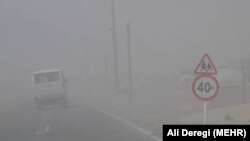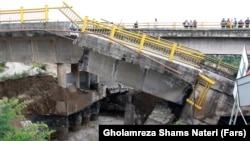Massive dust storms have hit the two southern provinces of Kerman and Sistan and Baluchistan, while six northern provinces of the country are submerged in floods.
More than 150 have been hospitalized for pulmonary complications and other medical issues resulting from a dust cloud that descended over Kerman and Sistan and Baluchistan in last few days.
The level air quality is still dangerous in the cities of Kerman, Fahraj, and Rigan, the head of Kerman province’s Environment Department Reza Jazinizadeh told the Islamic Revolutionary Guards Corps (IRGC)-run news agency, Tasnim, October 7.
The concentration of fine dust in the province currently stands at 300 micrograms per cubic meter, while the normal volume of fine particle concentration is 150 micrograms per cubic meter, Jazinizade said.
The spokesman for the Iran Emergency Organization Mojtaba Khaledi said 26 of the victims are still hospitalized.
The sand storm and winds with an average speed of 104 km (roughly 65 miles) per hour increased the volume of dust particles hanging in the air to nineteen times the permissible level, forcing schools in the city of Hirmand to close October 7. Schools in most of the cities of Kerman and Sistan and Baluchistan will be closed today if dust particle levels remain hazardous.
The mainly Sunni populated Sistan and Baluchistan province, the second largest province of Iran with 180,726 km2 (69,779 sq. mi) area, is the poorest region in the country, and has been repeatedly hit by several natural disasters, including storms, floods, and draughts.
Sistan and Baluchistan is not the only province to experience dust storms. In recent years, sand and dust storms in parts of southwestern Iran, including the oil rich province of Khuzestan, have caused periodic closures of schools, government offices, and businesses, bringing life to a standstill for residents. Many also fear the impact on their health.
Draught, dust storms, and air pollution in recent years have forced residents of Khuzestan to emigrate to the neighboring provinces.
The Islamic Republic authorities, including President Hassan Rouhani, have repeatedly blamed excessive dam construction in Turkey for kicking up dust and drying out the land, worsening the dust storms that periodically hit Iran.
Sixty wetlands in Iran, including nearly 44 percent of Iran's total marshlands, have dried up, the deputy head of the Environment Department for wetlands says.
“There are some 105 wetlands in Iran stretching three million hectares of land. About 1.3 million hectares of these wetlands are affected by drought, which led to total the dryness of some 60 wetlands,” state-run Iran Labor News Agency (ILNA) quoted Masoud Bagherzadeh as saying June 1.
Meanwhile, at least four people were killed in the floods that have been devastating Iran’s northern province of Mazandaran since late Friday, Tasnim reported Saturday quoting the region's medical emergency center. Three people drowned, while another victim was killed by a lightning strike. The disaster also damaged buildings and cut electricity in some parts of the province.
Over the past two days, the four northern provinces of Mazandaran, Gilan, Ardabil, and West Azarbaijan were hit by floods.
Analysts say the Islamic Republic has no real strategy in place to respond to these natural disasters. Nearly a decade ago, scientists and researchers published climate diagrams and cautioned that because of the change in the pattern of winds blowing and global warming, the southern half of Iran would face severe drought, while the northern half of it would struggle with overwhelming floods. Yet the caution fell on deaf ears, the experts insist.
Without an effective government plan to curb the problems stemming from climate change, Iran is expected to experience more natural disasters in the future.






